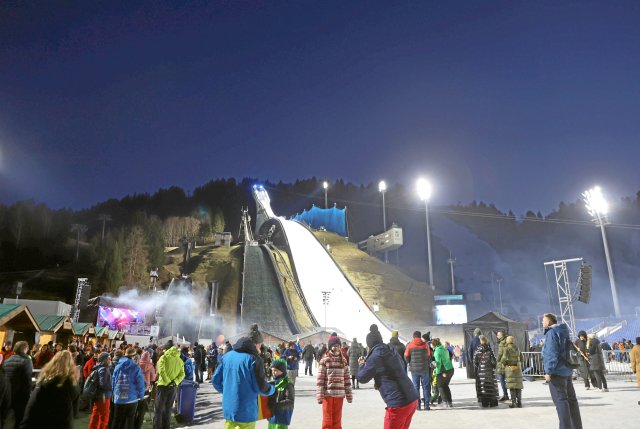In Garmisch-Partenkirchen, as in Oberstdorf, there was a lot of space at the jumps for the women’s jumping.
Photo: imago/Ulrich Wagner
TNT – the abbreviation of the ski jumpers’ new two-night tour promised explosive power. But the premiere in Garmisch-Partenkirchen and Oberstdorf, which was supposed to pave the way for a women’s Four Hills Tournament, only halfway met expectations at best. And that wasn’t just due to the disappointing performance of the German team, which is used to success, for which record world champion Katharina Schmid only ended up in 13th place in the overall ranking as the best flyer.
»It wasn’t all bad, but we have higher standards in terms of sport. A German national ski jumping team should position itself further ahead,” commented Horst Hüttel. According to the World Cup sports director, the premiere was organizationally successful: »In the TV ranking, the jumping in Garmisch-Partenkirchen took fourth place on ARD. People out there took part in this format.«
That may be right for the ski jumping fans in the warm living room, but the number of spectators at the jumps was well below expectations. After 3,500 spectators in Garmisch-Partenkirchen witnessed Luisa Görlich’s tenth place as the best German individual placement of this mini tour, only 3,000 fans came to the Bakken in Oberstdorf on New Year’s Day. The German Ski Association (DSV) had also expected at least twice as many visitors given the low entry prices and a 50 percent discount for a combination ticket with the men’s Four Hills Tournament tickets.
For comparison: a total of 46,500 spectators came to the sold-out arenas for the two men’s competitions of the Four Hills Tournament at the same location. The women are also still clearly lagging behind when it comes to prize money: While TNT overall winner Nika Prevc from Slovenia received 10,000 euros, the men’s overall tour winner is waiting for more than ten times that plus the coveted Golden Eagle trophy.
Which would mean one of the main problems for the hoped-for introduction of the women’s Four Hills Tournament: the issue of money. “While the marketers, the ski associations ÖSV and DSV and the organizer locations in Austria and Germany make real money on the men’s tour, the women’s World Cups are mostly still a subsidy business,” explains German ski jumping legend Martin Schmitt, himself the owner of a marketing agency. Roughly speaking, the income from a women’s event is at most a tenth of that of men. Everyone involved would have to make financial concessions for the women’s Four Hills Tournament.
Nevertheless, there is a letter from the four organizer cities in which they basically declare their willingness to hold the women’s Four Hills Tournament. »We got the ball rolling with the two-night tour. In retrospect, we will evaluate exactly what the balance sheet looks like in terms of sport, media technology and finance,” says Horst Hüttel. A clear German position will then be formulated and discussed with colleagues from the neighboring country.
The Austrian Ski Association (ÖSV) had blocked the holding of a women’s four-hills tournament this winter; instead of at the men’s tour locations of Innsbruck and Bischofshofen, the women will jump twice on the small hill in Villach this Wednesday and Thursday. However, this decision has a history, because three years ago the DSV opposed the introduction of a women’s four-hills tournament. Now Germany is leading the way for “equal ski jumps”, although the two competitions on the Two-Nights Tour were jumped in the reverse order to those on the men’s tour.
»The only option for the ÖSV is to have the women’s tour take place parallel to the men’s tour for logistical reasons and because of the TV broadcasts. We want to create a product that, just like the men’s tour, will last for 70 years and more,” explained Mario Stecher, the ÖSV’s sports ski jumping director these days. The prerequisite for this, however, is floodlights at the Bergisel ski jump in Innsbruck, the last of the four men’s tour ski jumps where artificial light is still missing.
“In this regard, it looks like we can get this done in 2026,” says Stecher. So there is a risk of another longer wait for equal rights in the air – certainly an explosive decision for the combative women flying scene.
Subscribe to the “nd”

Being left is complicated.
We keep track!
With our digital promotional subscription you can read all issues of »nd« digitally (nd.App or nd.Epaper) for little money at home or on the go.
Subscribe now!
pragmatic play sbobet sbobet88 judi bola
